Introduction:
In plug-in hybrids and fully electric vehicles, we discuss capacity and power. These data are essential when purchasing a vehicle as they help determine, among other things, the range and charging times. For many, the key question for choosing a car is: How many miles does a vehicle travel on a single charge, and how quickly does the battery recharge from empty to full? We often encounter the units kW and kWh, but confusion frequently arises about their exact meaning. In this section, we explore the meanings of capacity and power alongside the units kW and kWh. Additionally, we describe what the consumption of an EV entails and the three ways consumption can be found in instructions or displayed on the dashboard.
Range:
Range refers to the distance a vehicle can travel on one tank of fuel or a full battery charge. It is expressed in kilometers. Many factors can negatively impact the range. Below are a few considerations:
- driving style: rapid acceleration and incorrect engine braking:
– internal combustion engine: the engine does not inject fuel during deceleration;
– electric vehicle: energy is recuperated to the battery during gentle braking. During harsh braking, energy is “lost” as the brake pads press against the rotors; - vehicle weight: more weight results in higher consumption;
- aerodynamics: a bike rack or roof box increases consumption due to air resistance;
- low tire pressure;
- low outside air temperature;
- many engaged electrical consumers (such as seat heating or electric heater);
- engaged air conditioning.
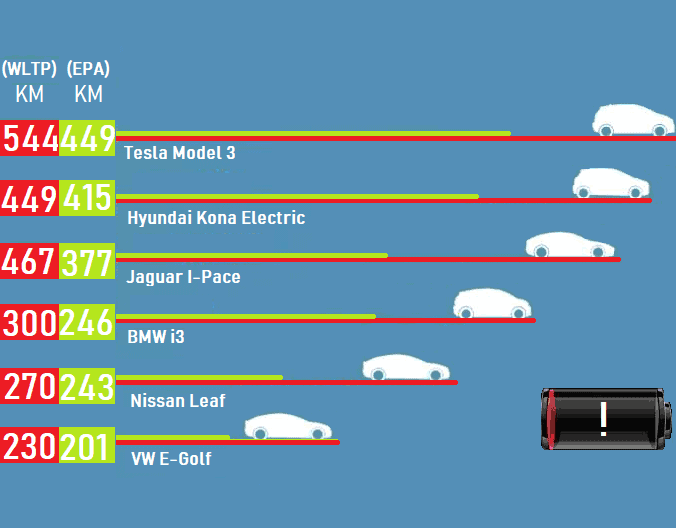
The driver has a significant influence on the range. By considering the above points, vehicle consumption can be reduced, achieving a higher range.
Power [kW]:
Power is the amount of energy that can be delivered in one second. Energy is measured in joules. 1 J/s (joules per second) equals 1 Ws (watt-second). The term watt-second is uncommon, and we refer to the unit as “watt.”
1 kW = 1000 watts = 1000 J/s = 1000 joules in 1 second.
In electric vehicles, power is encountered during the charging or discharging of the vehicle and the power delivered to the wheels:
- charging via an emergency charger (mode 2) at home from a wall socket with a power of 2.3 kW;
- charging via a fast charger along the highway (mode 4) with a power of 43 kW;
- the power delivered by the electric motor (torque multiplied by angular speed) without accounting for losses in the drivetrain:
– BMW iX3: 210 kW;
– Peugeot e-208: 115 kW;
– Volkswagen ID.5: 128 kW.
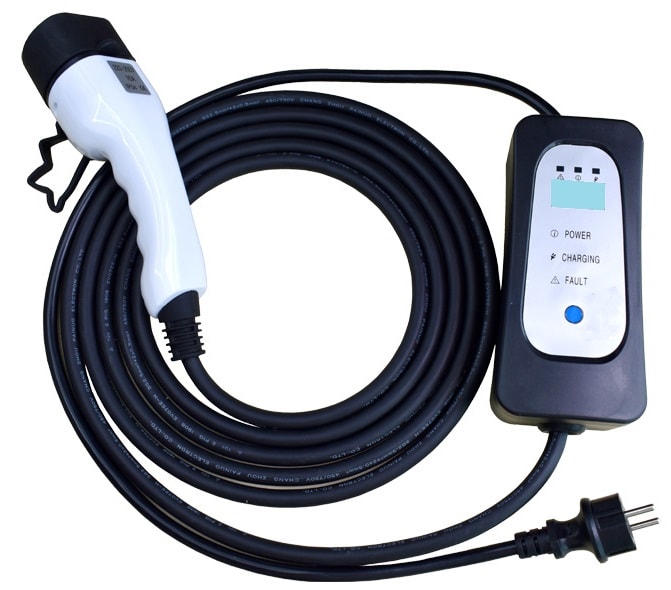
Capacity [kWh]:
Capacity refers to the amount of energy a battery can store. The higher the battery’s capacity, the greater the range will be.
In electric vehicles, kilowatt-hour [kWh] is often used as a measure for energy and battery capacity.0aAs an example, the capacity of three fully electric vehicles is shown:
- BMW iX3: 74 kWh;
- Peugeot e-208: 50 kWh;
- Volkswagen ID.5: 77 kWh.
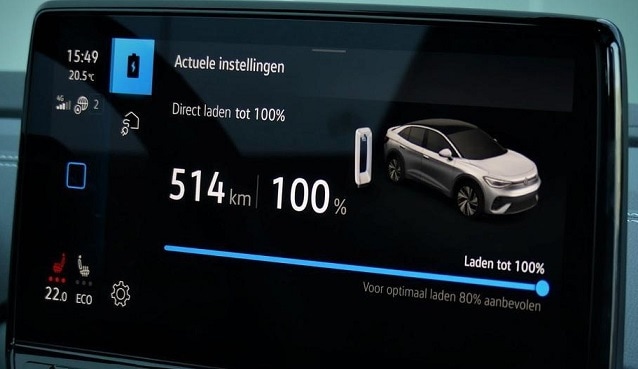
Capacity in kilowatt-hour arises from three factors:
- Kilo: multiplication factor x 1000;
- Watt: unit of power;
- Hour: an hour contains 60 minutes of 60 seconds, totaling 3,600 seconds.
One kilowatt-hour [kWh] equals 3,600 kilowatt-seconds [kWs].
Consumption [Wh/km, km/kWh, kWh/100 km]:
The charging power, consumption, and delivered power of electrical devices are often expressed in the unit “watt.” When an appliance with a consumption of 100 watts runs for an hour, it consumes 100 watt-hours (Wh) of energy. If this device runs for ten hours, it consumes 100 watts * 10 hours = 1,000 watt-hours (1,000 Wh), equivalent to 1 kWh (1 kilowatt-hour).
To calculate the cost to fully charge a battery, multiply its capacity (in kWh) by the price per kWh.
To calculate vehicle consumption, convert the capacity to watt-hours and divide it by the kilometers the vehicle can drive before the battery is depleted. Specifications often express consumption in Wh/km.
The vehicle’s dashboard can also show consumption as km/kWh or kWh/100 km. This is analogous to viewing internal combustion engine consumption in terms of km/l (kilometers per liter) or l/100 km (liters per 100 kilometers).
These consumption values can be converted between each other.
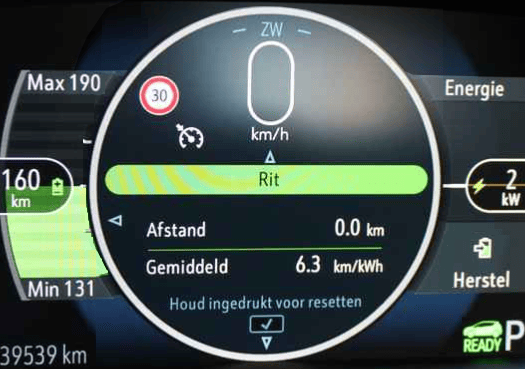
The columns below explain the three types of consumption display and show the general formula with filled-in examples for each display type.
Wh/km:
The HV battery of the BMW iX3 has a capacity of 74 kWh. This car’s consumption is 192 Wh/km, indicating how many watt-hours (0.001 kWh) per kilometer the car consumes. Thus, the BMW iX3 travels approximately 385 km on its 74 kWh battery.
The consumption is then: 74,000 Wh / 385 km = 192 Wh/km.

Km/kWh:
The consumption monitor on the dashboard or in the onboard computer can display current or average consumption in km/kWh. For the BMW iX3 with a consumption of 192 Wh/km, divide the number 1000 (kWh) by 192 (Wh). The ratio is 5.21. Per kWh, 5.21 km can be driven. Therefore, the dashboard shows an average consumption of 5.2 km/kWh. Naturally, this is an average consumption, and actual consumption depends on driving conditions.
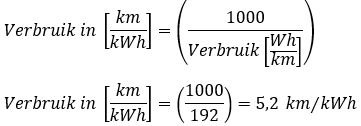
kWh/100 km:
The consumption of the BMW iX3 can also be expressed in kWh per 100 km. The car has a battery capacity of 74 kWh and a range of 385 km. The consumption is calculated as follows: 74 kWh / 385 km.
When we divide the capacity by the range and then multiply the result by 100 ((74 / 385) * 100), we get the number 19.22.
This means that the consumption is 19.22 kWh per 100 km.

The following table shows the capacity, range, and consumption of the three vehicles in the three different ways.
An overview with examples regarding charging EVs is described on the page: Charging Electric Vehicles.

Related pages:
